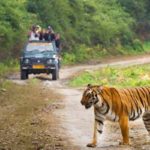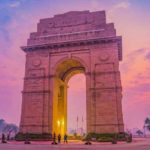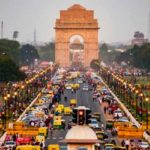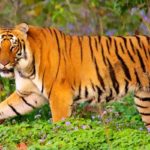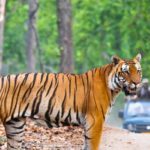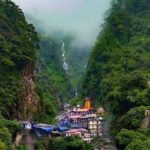If you need to plan a quick escape to some of these done-to-death as well as some offbeat places in India and change your opinion about the glorious rainy season of India. These are the places where you can truly sense the cool gentle winds, light raindrops and that smell of earth. Monsoons in India are truly a rhapsody of bliss, beauty and relief from the scorching summer sun and they are meant to be savoured.
Look at the Honeymoon Tours.
1. Jim Corbett, Uttarakhand

Just about 6 hours drive from Delhi, Jim Corbett National Park is a treat for wildlife lovers. The plus point of visiting Corbett during monsoon is that it’s not crowded. Rumour has it that Corbett National Park is closed during rainy season for safety reasons (and also partly because of breeding time) but out of the four zones – Dhikala, Bijrani, Durga Devi and Jhirna, Jhirna zone is open for visitors all around the year. You’ll be surprised to know that rafting in Jim Corbett is only possible during monsoon as Kosi river remains depthless rest of the year. A 3-hour long jeep safari is also prearranged every morning and evening that will let you go deep inside the forest to explore the serene flora and fauna. Riding on an elephant back is also possible during monsoon in Corbett as Elephant Safaris are also organized. It’s easier to spot animals like boars and antelopes and some bird species like parakeets, quails and barbets during the rainy season.
2. Udaipur, Rajasthan

This charming city is sprinkled with historic structures all around exuding regal grandeur. Home to the most sophisticatedly designed palaces, havelis, buzzing streets, and beautiful lakes. The city of Udaipur, also called the ‘Venice of the East’ comes alive during the months of July-August but remains an unpopular destination among travellers throughout the monsoon season. The city is well-equipped with a wide variety of hotels and lodging options that suit every pocket, restaurants that offer scrumptious Rajasthani dishes and bazaars that are popular for their handicrafts.
Surrounded by Aravilli Hills, Monsoon Palace was built in the year 1884 by Maharana Sajjan Sing for the purpose to keep a track of the movement of monsoon clouds. Formerly known as Sajjan Garh Palace, it has been recently opened for public. After the light showers of rain, the bird’s-eye views from the Monsoon Palace are remarkable – highlighting the lush greenery and enchanting lakes. Around eleven hours away from Delhi by road, Udaipur’s beauty only gets enhanced during the monsoons. Make sure you visit Lake Pichola, Fateh Sagar Lake, City Palace, Jag Mandir and Udaipur Ghat while you’re there.
3. Deoria Tal, Uttarakhand

A mixture of mythology and natural beauty make Deoria Tal an enchanting place to visit. Especially during the monsoons when the little lake is brimming with emerald green water. Located about 3 km on an uphill trek from the villages of Mastura and Sari, on the Ukhimath–Chopta road in Uttarakhand, this lake is believed to be the bathing places of devas according to the Puranas. It is surrounded by the snow-capped peaks of Chaukhamba, Nilkantha, Bandarpunch, Yellow Tooth, Kalanag and Kedar Range. On a clear day you might be lucky enough to catch a captivating reflection of these peaks on the lake waters. Enclosed by thick forests and lush greenery this place is a trekker’s delight. One needs to drive about 12 km to Sari Village from Ukhimath and from Sari Village one can reach Deoria Tal via a trek route of 2 km approx. There is no motorable road to Deoria Tal. The trek is a paved path from Sari Village up to Deoria Tal, although it is quite steep at some places. There are many rest houses or shelters on the trek.
4. Bishnupur, West Bengal

Located at a distance of about 150 km from Kolkata, Bishnupur is a hub for terracotta architecture, crafts and culture. For almost a thousand years, it was the capital of the Malla dynasty of Mallabhum, as a result of which it is today one of the principal centres of culture in Bengal. Most of the exquisite terracotta temples were built during this time, in the 16th century, and are today a huge part of Bishnupur’s lure. August marks the beginning of Monsoon season in Bishnupur and it lasts till early October. The place looks beautifully fresh. The stunning terracotta structures having been washed by the rains obtain a striking reddish orange hue which is seriously eye-catching against the greenery around.
Apart from the exquisite architecture, it is also famous for its terracotta crafts and Baluchari sarees which are made of a pure silk weave and feature motifs representing Indian mythology. The Bishnupuri School of Hindustani Classical Music and the Bishnupur School of Painting are also widely known. Be sure to wander the area and explore the Malleshwar Temple, which is the oldest temple in the area.
5. Goa

During the monsoon season, there is much more to Goa than just those pristine beaches and picturesque landscapes. Dudhsagar Falls is one such place to get a thrill of the rainy weather. Situated in the southern part of Goa – Mollem and in close proximity to the Karnataka border, Dudhsagar waterfall is at its best and is much-admired throughout the monsoon. During the months of June to September, Dudhsagar waterfall is picture perfect with thriving green forests. From a distance, the waterfall looks like the flow of milk down the mountains and hence, the name Dudhsagar, literally meaning ‘Sea of Milk’. Don’t forget to take a dip in the refreshing cool water while embracing nature.
6. Kutch, Gujarat

Located in the northwest side of Gujarat, Kutch is the largest district in India. Rann of Kutch has 18 cultural tribes which makes the place well-liked among travellers. The never-ending desert plains with surreal horizon in the monsoon give an enticing view. Kutch is even more dreamlike during the monsoon as it gets submerged in the water. For rest of the year, it’s an enormous stretch of white salt appearing to give the look of a white desert. On the full moon nights, cultural programmes are organized at Dhordo to celebrate Gujarat’s rich culture and traditions. One of the must-things-to-do in Rann of Kutch would be – a moon light camel safari.
7. Malshej Ghat, Maharashtra

An alluring hill station at an altitude of 700 metres above the sea level, Malshej Ghat is a captivating tourist destination because of its refreshing climate. Well-known for its numerous lakes, gushing waterfalls, and charming mountains, this hill station is a favorite tourist destination among adventurers and nature lovers. A typical woody countryside, Malshej Ghat is renowned for its rich flora and fauna. Though Malshej Ghat is a year round tourist destination, monsoon brings amazing charm to this beautiful hill station. The verdant valleys and woody forests of Malshej react to the call of the monsoon by flaunting the beauty of its lakes and waltzing waterfalls and the misty fog at the top. The beauty and charm of this marvelous hill station is more visible when it is under heavy fog and dark clouds. But what make Malshej Ghat so eminent are the large flock of migratory Pink-legged Flamingos coming from Siberia. Their mating dance is an eye-catching spectacle.
8. Ladakh, Jammu & Kashmir

Ladakh is an amazing place to visit especially during the monsoon season. This region does not experience rains like anywhere else in India, making it a perfect time to travel here. Leh’s Buddhist monasteries and historical monuments are the biggest attractions for visitors. There is an 800 year old Kali Mandir located in the heart of the town that houses a fascinating collection of masks. The 17th Century Leh Palace built in traditional Tibetan style offers an enthralling view of the town. Leh has a lot to offer for nature and adventure lovers as well in the form of para gliding and hiking. You can choose your trekking trails if you wish to go in for a long trek. White water rafting is also possible during this time along the Indus River in Leh as well as the Shayok River in the Nubra Valley. The Nubra Valley, on Khardung La, has the world’s highest motorable road which adds to it being another unforgettable trip. The hanging glaciers, green villages, Buddhist monasteries on the way along the Zanskar River make this journey even more spectacular.
There are camel safaris in Nubra Valley as well. The blue-black Pangong Lake is another must visit with part of it running into China. The journey though long is beautiful starting from Thiksey village which has a gigantic monastery to passing the huge mountains and finally the Changla pass. Another reason to visit this place is the Ladakh festival that takes place during the first two weeks of September. The festival opens in Leh with a spectacular procession through the streets with the villagers dressed in traditional costumes, dance and sing folk songs.
9. Shantiniketan, Kolkata

Every year more and more curious travellers are visiting Shantiniketan to get a feel of the place, which was grown and nurtured by the Noble laureate Rabindranath Tagore. Though, it can be visited any time of the year, it looks lovely in the rains. Shantiniketan as we know it today was shaped by Rabindranath Tagore, who started an open-air school 40 years after his father had founded an Ashram here in 1863. A place thus conceived where the cultures of the East and the West could meet in camaraderie and thereby strengthen the fundamental condition of world peace.
Shantiniketan resembles a lush green resort when after a long summer spell rains decide to wet the earth. There are a number of places that you can check out. The Visva Bharati campus has a number of buildings that are known for their unique architecture. There are beautiful gardens around that present a pretty picture. The Varsha Mangagal is celebrated in July-August. Cultural shows are held and a tree planting ceremony is preceded by Halokarshan (ploughing). Besides the in-campus highlights, there are a good number of places located around Shantiniketan. Kankalitala, 9 km away on the bank of the Kopai river is a sacred Hindu shrine. Deer Park (closed on Wednesday), 4 km from Shantiniketan is another interesting place to visit. Nanoor, 23 km from Shantiniketan is the birth place of the 14th century Vaishnava poet Chandidas. Regular buses are available from Bolpur Railway Station. One can also visit Joydev-Kenduli, which is the birth place of Joydev, the author of Geet Govinda, the 12th century masterpiece in Sanskrit
10. Munnar, Kerala

The undulating hills of Munnar, South India’s prime tea-growing regions, are carpeted in emerald-green tea plantations. The low mountain panorama is splendid especially during the monsoons when mist envelopes the mountain tops.
Even though many tourists avoid Munnar during the monsoons, this is a great time to visit the hill station if you’re looking for a quiet vacation. Covered with lush green foliage, monsoons in Munnar have a charm of their own. This is also a great time to enjoy discounts on hotel tariffs and enjoy Munnar without throngs of tourists. You must carry an umbrella or raincoat along.

